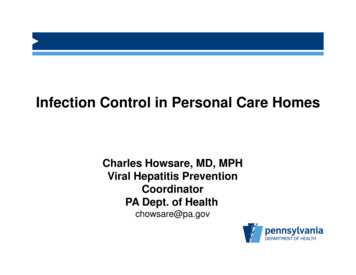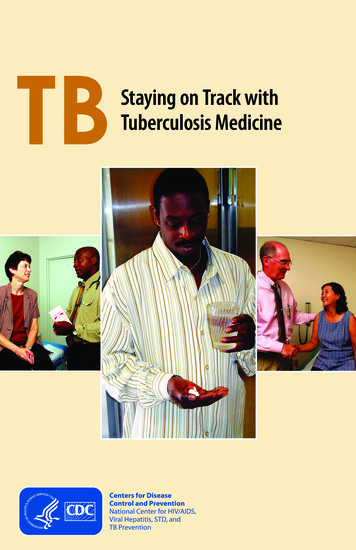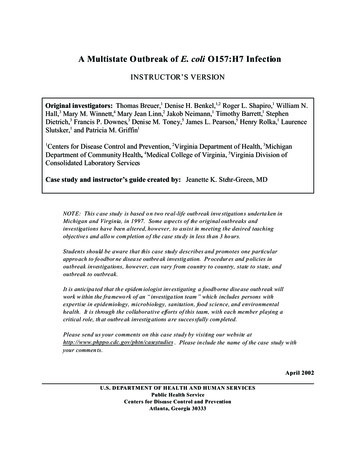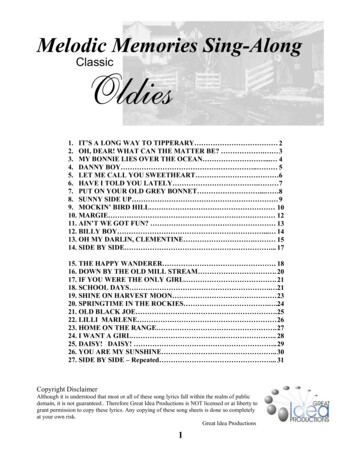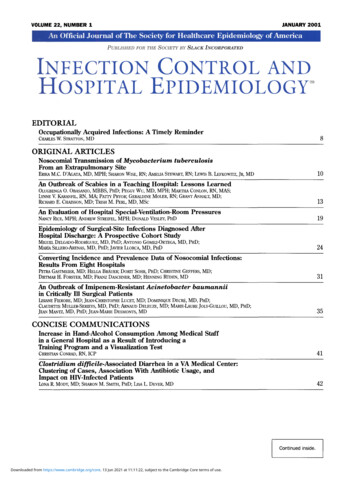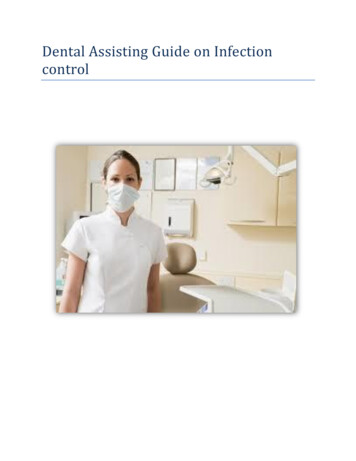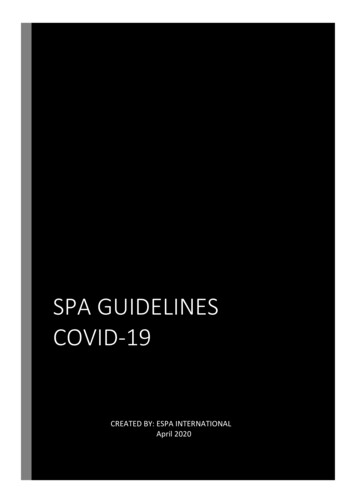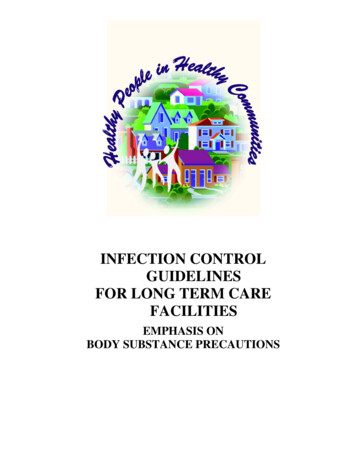
Transcription
INFECTION CONTROLGUIDELINESFOR LONG TERM CAREFACILITIESEMPHASIS ONBODY SUBSTANCE PRECAUTIONS
MISSOURI DEPARTMENT OF HEALTHAND SENIOR SERVICESSECTION FOR LONG TERM CAREAND THEADVISORY COMMITTEE ON INFECTION PREVENTIONAND CONTROLEXTENDS SINCERE APPRECIATIONTOJOHN MORLEY, MB, BCHANDNINA TUMOSA, PH.DDIVISION OF GERIATRIC MEDICINEST. LOUIS UNIVERSITY, SCHOOL OF MEDICINEANDTHE GERIATRIC RESEARCH, EDUCATION, AND CLINICALCENTER, ST. LOUIS VAMCFORTHE GENEROUS GIFT OF 1500 COPIES OF THIS MANUALAND 750 NOTEBOOKS TO ALLOW INITIAL, ONE-COPY,FREE-OF-CHARGE DISTRIBUTION TO ALL PAST USERSOF THIS DOCUMENT
INFECTION CONTROLGUIDELINESFOR LONG TERM CAREFACILITIESEMPHASIS ONBODY SUBSTANCE PRECAUTIONS
INFECTION CONTROL GUIDELINESFOR LONG TERM CARE FACILITIESEMPHASIS ONBODY SUBSTANCE PRECAUTIONSJanuary 2005To the User:The Infection Control Guidelines for Long Term Care Facilities, Emphasis on BodySubstance Prevention was removed from the Department of Health and Senior Serviceswebsite in December 2004. Outdated material was removed from the document and thenreloaded onto the website. The following materials were removed:Figure 2.1-2 Disease Case Report Form (CD-1)Figure 9.1-1 Tuberculin Testing RecordFigure 9.2-1 Disease Case Report Form (CD-1)Figure 9.2-2 Tuberculosis Drug Monitoring Form (TBC-1)Appendix J Appendix C – LinelistingAppendix K Attachment B – Summary of Foodborne OutbreakInvestigationAttachment C – LinelistingAttachment D – Nosocomial Outbreak Report FormThe Department of Health and Senior Services is responsible for protecting and promotingquality of life and health for all Missourians by developing and implementing programs andsystems that provide information and education, effective regulation and oversight, qualityservices, and surveillance of diseases and conditions.Published byMissouri Department of Health and Senior ServicesP.O. Box 570Jefferson City, MO 65102-0570Alternate forms of this publication for persons with disabilities may be obtained by contacting theMissouri Department of Health and Senior Services, Section for Long Term Care,P.O. Box 570, Jefferson City, MO 65102-0570, Ph: (573) 526-8524.TDD users can access the preceding phone number by calling 1-800-699-8819.AN EQUAL OPPORTUNITY/AFFIRMATIVE ACTION EMPLOYERServices provided on a nondiscriminatory basis
AcknowledgmentsThis document was developed in 1992 as the product of a consensus workgroup formed todevelop a plan on the prevention and control of methicillin resistant Staphylococcus aureusand other antibiotic resistant organisms in long term care facilities. Consensus was achievedfollowing four meetings held in 1991, with representatives from key health care agencies andorganizations geographically distributed throughout Missouri. Representatives broughtexperience in long term care, infection control, infectious diseases, pharmacy,administration, and public health. The original document was subsequently printed severalthousand times, distributed statewide to all long term care facilities and sent by request toover thirty states and Canada.There has been a continuing need to discuss critical issues related to emerging infectiousdiseases and infection control in the community and in all types of health care facilitiesstatewide. Because of this need, the 1991 consensus group was recognized in 1995 as theadvisory body to the Missouri Department of Health and officially named the AdvisoryCommittee on Infection Prevention and Control. Members of the Revision Committee havecontributed time and expertise to the revision of this 1999 edition, which is endorsed by theentire Advisory Committee.1999 Revision Committee:Co-Coordinators: Marge Borst, RN, BS, CIC, Department of Health & Senior ServicesMary E. Kliethermes, RN, BS, Department of Health & Senior ServicesCaryl Collier, RN, MPH, CIC, Department of Health & Senior ServicesHerb Forim, MS, MT, (ASCP, RM), Christian Hospital NEJanet Franck, RN, MBA, CIC, Independent Infection Control ConsultantEddie Hendrick, BS, MT, (ASCP), CIC, UMC Hospitals & ClinicsBetty Markway, RN, MSN, Missouri Department of Health and Senior ServicesLynn Meyer, BSN, MPH, CIC, St. John's Mercy Medical CenterPatti Reynolds, RN, BSN, CIC, St. John's Regional Health CenterAdvisory Committee on Infection Prevention and Control:Joy Baer, MT, ASCP, Boyce and Bynum LabsDavid W. Bentley, MD, VA Medical CenterMarge Borst, RN, BS, CIC, Department of Health & Senior ServicesCarl G. Bynum, DO, MPH, Missouri Patient Care Review FoundationGordon Christensen, MD, Society for Healthcare Epidemiology of America, Inc. (SHEA)Caryl Collier, RN, MPH, CIC, Department of Health & Senior ServicesH. Denny Donnell, Jr, MD, MPH, Department of Health & Senior ServicesHerb Forim, MS, MT, (ASCP, RM), Christian Hospital NEJanet Franck, RN, MBA, CIC, Independent Infection Control ConsultantJames Gray, PharmD, Missouri Board of PharmacyEdith Hamilton, PhD, Missouri Nurses AssociationRobert H. Hamm, MD, MPH, Missouri Department of Health and Senior ServicesEddie Hendrick, BS, MT, (ASCP), CIC, UMC Hospitals & Clinics
Richard Heimburger, MD, Missouri State Medical AssociationMary E. Kliethermes, RN, BS, Department of Health & Senior ServicesBetty Markway, RN, MSN, Missouri Department of Health and Senior ServicesGloria Metzger, RN, BSN, Missouri Hospital AssociationLynn Meyer, BSN, MPH, CIC, St. John's Mercy Medical CenterJo Micek, RN, CIC, St. Joseph Health CenterBeverley Payne, MPH, State Public Health LaboratoryPatti Reynolds, RN, BSN, CIC, St. John's Regional Health CenterWilliam L. Salzer, MD, University of MissouriMahree Fuller Skala, MA, Department of Health & Senior ServicesVic Tomlinson, Department of Health & Senior ServicesMarion Warwick, MD, MPH, Department of Health & Senior ServicesMark D. Winton, MD, Jefferson City Medical GroupPilot Study Group:David D. Cravens, MD, MSPH, Department of Family and Community Medicine,School of Medicine, University of Missouri-ColumbiaPam Shipman and Arlene Gricko, Delmar Gardens Enterprises, Inc., St. Louis, MOA special thanks goes to the following: Joyce Muenks and Connie Lepper for forms creationand document development in Microsoft Word; and to Diane Rackers for updating andformatting this revision.
INFECTION CONTROL GUIDELINESFOR LONG TERM CARE FACILITIESEMPHASIS ON BODY SUBSTANCE PRECAUTIONSTABLE OF CONTENTS1.01.11.2IntroductionA Guide to Using This ManualUpdates/Revisions2.02.1SurveillanceRoutine Infection Control Surveillance in Long Term CareFigure 2.1-1. Infection Control Line ListingFigure 2.1-2. Disease Case Report Form (CD-1)Figure 2.1-3. Antibiotic Usage ReportFigure 2.1-4. Incidence Rate and Number of Body Site Infectionsper Resident Days by UnitFigure 2.1-5. Rates of Clostridium difficile Infections and Positive Toxin AssaysFigure 2.1-6. Incidence Rates of MRSA Nosocomial Colonization and InfectionFigure 2.1-7. Sample: Environmental Rounds Surveillance FormFigure 2.1-8. Maintaining Infection Control Practices—A Checklist forHousekeeping PracticesDefinitions of Body Site Infections in Long Term Care FacilitiesFrequent Indicators of Infection in the ElderlySymptoms of Worsening Condition2.22.32.43.03.13.2Body Substance PrecautionsBody Substance Precautions SystemImplementing the Body Substance Precautions System Gloves Handwashing Face and Eye Protection Apron or Gown Sharps Handling and Disposal Employee Health Handling Laboratory Specimens Soiled Linen Disposal of Regulated Waste From Resident’s Rooms Environmental Cleaning Cardiopulmonary Resuscitation (CPR) Resident Placement, Activity Restriction and the Use of Private Rooms forInfection Prevention and Control Physician’s Role in Implementing the Body Substance Precautions System Role of Nurses and Other Health Care Workers in Implementing the BodySubstance Precautions System Precautions for Residents With Airborne Diseases Figure 3.2-1. Stop Sign Alert
3.33.4Diseases Transmitted by Airborne RouteExamples of Situations Using the Body Substance Precautions System4.04.1Collection and Transport of Laboratory SpecimensProcedures for Specimen Collection and Transport Safety Considerations General on Recommendations for Residents of Long Term Care FacilitiesEmployee Immunization RecommendationsWork Restrictions for Health-Care Workers (HCWs) Exposed to or Infected WithCertain Vaccine-Preventable Diseases6.06.1Transfer of ResidentsTransfer of Residents Between FacilitiesFigure 6.1-1 Sample: Long Term Care Patient Transfer Form7.07.17.2Infectious Disease OutbreaksInfectious Disease OutbreaksFigure 7.1-1. Investigation of a Potential MRSA OutbreakFigure 7.1-2. Sample: Patient/Resident Survey Form for Rash ConditionFigure 7.1-3. Sample: Employee Questionnaire For Rash ConditionFigure 7.1-4. Sample: Generic Outbreak Medical Record Review FormFigure 7.1-5. Line List FormFigure 7.1-6. Sample: Employee Questionnaire Related to OutbreakFigure 7.1-7. Nosocomial Outbreak Report FormParasite/Organisms of Concern in Long Term Care8.08.1Influenza OutbreaksInfluenza Outbreak Control for Long Term Care Facilities9.09.1Tuberculosis ControlGuidelines for Screening for Tuberculosis in Long Term Care FacilitiesFigure 9.1-1. Tuberculin Testing RecordFigure 9.1-2. Annual Statement for Tuberculin ReactorsGuidelines for Tuberculosis Contact Investigation in Long Term Care FacilitiesFigure 9.2-1. Disease Case Report Form (CD-1)Figure 9.2-2. Tuberculosis Drug Monitoring Form (TBC-1)Transfer of Residents With Suspected or Confirmed TuberculosisInstructions for Facilities Equipped to Manage Residents With Suspected orConfirmed nfectious Disease Fact SheetsClostridium difficile Diarrheal DiseaseConjunctivitis (Pink Eye, Sticky Eye)Head Lice Infestation (Pediculosis)Hepatitis AHepatitis BHepatitis C
sistant Staphylococcus aureus (MRSA)ScabiesShingles (Herpes Zoster)TuberculosisVancomycin-Resistant Enterococci (VRE)11.011.1Infection Control ResourcesInfection Control ResourcesAppendicesA. Manual AcronymsB. Glossary of Infection Control Terms and DefinitionsC. Division of Aging, "Rules for Intermediate Care, Skilled Nursing and Residential CareFacilities"D. Health Care Financing Administration, "Rules for Certified Facilities"E. Department of Health, "Tuberculosis Testing Rule"F. Department of Natural Resources, "Infectious Waste Rules"G. Department of Health, "Infectious Waste Definitions"H. Department of Health, "Health Care Provider Rules"I. Department of Health, "Reporting Rule"J. Department of Health "Guidelines for Scabies Prevention and Control"K. Department of Health, "Guidelines for Investigation of Gastrointestinal Illness ofUndetermined Origin in Long Term Care Facilities
Section 1.0: IntroductionSubsection: Table of ContentsINTRODUCTIONTABLE OF CONTENTS1.01.11.2IntroductionA Guide to Using This ManualUpdates/RevisionsINFECTION CONTROL GUIDELINES FOR LONG TERM CARE FACILITIES
Section 1.0: IntroductionSubsection 1.1 A Guide to Using This ManualINTRODUCTIONA Guide to Using This ManualThis document contains scientifically based information to improve the assessment ofresidents. It provides nursing professionals with criteria for identifying specific body-siteinfections. This enhances the objectivity of reporting signs and symptoms to providers andhelps providers make decisions whether or not to culture sites, order other diagnostic tests,and/or prescribe treatment, including antimicrobials.Health care professionals in long-term care facilities can find detailed guidelines in thisdocument for the care of residents with specific body-site infections, as well as principlesand practices for preventing the spread of infectious organisms to other residents and staff.Recommending measures to prevent and control the development or spread of antibioticresistant organisms remains one of the primary purposes of this document. Infection controlpractices are effective when they are understood and carried out by the staff, regardless ofstaff turnover. These practices must be monitored for residents known to be infected withcertain organisms and for residents who are unknowingly infected and/or are asymptomaticcarriers of the organisms.The use of this manual should not be limited as a guide for individual resident care, butshould be used to establish high quality infection control programs in Missouri long-termcare facilities. The manual provides tools for evaluating the incidence of resident or staffinfections on specific wards, wings or units in a facility. The epidemiology of evaluatinginfections by time, place, and person is possible with the use of these tools. Trends can bedemonstrated with the use of tables, charts, and graphs in order to illustrate where infectioncontrol problems exist and where quality improvement is needed.In summary, this manual is intended to be a working document for the staff on each unit andfor policymakers in a long term care facility. It will not be helpful to physicians, nurses,technicians, certified nurse assistants, orderlies, or administrative personnel if it is not readilyavailable as a resource.We, the Advisory Committee on Infection Prevention and Control, Missouri Department ofHealth, encourage users to give us feedback on the benefits and the need for further revisionsof this document. With feedback from users, we can all contribute to the assurance thatresidents in long term care facilities are provided with quality infection control practices.INFECTION CONTROL GUIDELINES FOR LONG TERM CARE FACILITIES
Section 1.0 IntroductionSubsection 1.2 Updates/RevisionINTRODUCTIONUpdates/RevisionsThe "Infection Control Guidelines for Long Term Care Facilities Emphasis on BodySubstance Precautions" manual will be made available via the Internet through theDepartment of Health Home Page at http://www.dhss.mo.gov. The manual can be foundunder Applications & Forms.Future updates and/or revisions to this manual will also be made available through thedepartment's web site. Updates and/or revisions will be added to the main manual and willalso be available individually to make it easier to identify updates. Updated manual sectionscan also be identified by checking the page headers.Written notice of the initial availability of revisions and/or updates on the department's website will be mailed to recipients who received the manual in paper form. Should access to thedepartment's web site be unavailable to a manual recipient, paper copies of updates and/orrevisions may be requested and will be provided at a fee to cover the cost of printing andshipping.If you have questions about manual updates and/or revisions, please contact the Section forLong Term Care at (573) 526-8524.INFECTION CONTROL GUIDELINES FOR LONG TERM CARE FACILITIES
Section 2.0: SurveillanceSubsection: Table of ContentsSURVEILLANCETABLE OF CONTENTS2.02.12.22.32.4SurveillanceRoutine Infection Control Surveillance in Long Term CareFigure 2.1-1. Infection Control Line ListingFigure 2.1-2. Disease Case Report Form (CD-1)Figure 2.1-3. Antibiotic Usage ReportFigure 2.1-4. Incidence Rate and Number of Body Site Infectionsper Resident Days by UnitFigure 2.1-5. Rates of Clostridium difficile Infections and Positive Toxin AssaysFigure 2.1-6. Incidence Rates of MRSA Nosocomial Colonization and InfectionFigure 2.1-7. Sample: Environmental Rounds Surveillance FormFigure 2.1-8. Maintaining Infection Control Practices—A Checklist forHousekeeping PracticesDefinitions of Body Site Infections in Long Term Care FacilitiesFrequent Indicators of Infection in the ElderlySymptoms of Worsening ConditionINFECTION CONTROL GUIDELINES FOR LONG TERM CARE FACILITIES
Section 2.0 SurveillanceSubsection 2.1 Routine Infection Control SurveillanceSURVEILLANCERoutine Infection Control Surveillance in Long Term CareThe primary purpose of infection control surveillance is the collection of information foraction.1 It is more than just evaluation of laboratory reports, including cultures. Infectioncontrol includes routine surveillance of residents, surveillance of staff, and surveillance ofthe environment. This may be accomplished using the following guidelines.Epidemiologic Aspects1. According to the Missouri Division of Aging rules, all long term care facilities must haveinfection control policies which are made evident to all new employees at time oforientation.2 [13 CSR 15-14.042(20) and 13 CSR 15-15.042(18) See Appendix C.] TheOccupational Safety and Health Administration (OSHA) mandates policies onsurveillance and recordkeeping of exposures to blood and body fluids included underUniversal Precautions (see other potentially infectious materials) and infections frombloodborne pathogens.3 In addition, infection control experts recommend that long termcare facilities (LTCF’s) have active, effective infection control programs which includeweekly surveillance for nosocomial infections and multiply resistant organisms.1,4 (See"Glossary of Infection Control Terms and Definitions," Appendix B.) Besidesidentification of such infections, a line listing should be kept which includes pertinentinformation regarding residents with infections (Figure 2.1-1).2. A facility's surveillance policies and procedures should be reviewed and updated on ayearly basis to assure appropriateness and effectiveness in reducing specific body siteinfections or number of infections with specific organisms.3. A facility's surveillance system must include the reporting of infectious diseases asrequired by the Missouri Department of Health. (See "Reporting Rule, Appendix I. SeeFigure 2.1-2 for a sample reporting form.)4. A facility's surveillance system should include monitoring for appropriate antibiotic use.A positive culture in a person without clinical symptoms rarely requires treatment withantibiotics. (See Figure 2.1-3 for a sample monitoring form.)5. Long term care facilities should request by contract or policy that their laboratory notifythe Director of Nursing (DON) or his/her designee of all positive cultures with a multiplyresistant organism or laboratory data indicative of a reportable disease. This will permitthe facility to track the residents with certain organisms. Tracking a multiply resistantorganism or reportable disease includes keeping records of dates when the residentchanges rooms or roommates and also monitoring resident activities or exposures toothers.6. It is important to track and follow trends of infection data related to both residents andstaff on a monthly basis. This information should then be presented to the appropriateINFECTION CONTROL GUIDELINES FOR LONG TERM CARE FACILITIES
Section 2.0 SurveillanceSubsection 2.1 Routine Infection Control Surveillancecommittee on at least a quarterly basis.1 Rates should be calculated by using resident daysor average daily census for the surveillance period (such as a month, quarter or year) asthe denominator. Examples of tools used in data calculation and presentation are includedin Figures 2.1-4, 2.1-5 and 2.1-6.7. Outbreak investigation should be performed as outlined in Section 7. Infectious DiseaseOutbreaks.Resident Aspects1. Assessment of all residents for any/all changes in symptoms or conditions which may beindicative of an infection should be performed on an ongoing basis; i.e., clinicalobservation, house reports, chart and/or Kardex review, culture reports.1 Any change inthe resident’s condition is to be reported to the private physician.2. Indications of infection in the elderly may vary from those seen in a younger more healthypopulation.5 Elderly persons often have a lower body temperature, so an increase intemperature from that which is normal for the resident may be an indication of infection.Other conditions that may indicate an infection in the elderly are:a. Presence of delirium (acute confusional state)b. Rapid major change (worsening) in function in activities of daily living (ADL’s)c. Loss of appetite, new or worsening urinary incontinence, cough, increased respiratoryrate, falls, or loose stoolsd. A decline in blood pressure or a rise in pulse ratee. A fall with no previous history of falling3. Routine culturing of any resident or group of residents should not be performed unless oneof the following occurs:a. Resident has clinical signs or symptoms. A culture done under these circumstanceswill be useful in treating the resident.6b. In an outbreak situation, as outlined in Section 7. Infectious Disease Outbreaks.4. Routine culturing of asymptomatic residents at admission or prior to admission is notrecommended. Residents who may be either colonized or infected with a diseaseproducing organism(s) can generally be cared for in the long term care setting by usingappropriate infection control practices. Request of culture results from the transferringfacility is appropriate upon transfer to assist the receiving facility in understanding clinicalhistory and assure appropriate resident room placement.5. Assessment of the resident at the time of admission to the facility for communicablediseases and a history of immunization. This will assure recognition of communicablediseases that will require special precautions and assure the resident is up-to-date onrecommended adult immunizations. (See Section 5. Immunizations.)6. In accordance with Department of Health rule 19 CSR 20-20.100 (See Appendix E), allresidents new to long term care who do not have documentation of a previous skin testINFECTION CONTROL GUIDELINES FOR LONG TERM CARE FACILITIES
Section 2.0 SurveillanceSubsection 2.1 Routine Infection Control Surveillancereaction 10mm or a history of adequate treatment of tuberculosis infection or disease,should have the initial test of a Mantoux PPD two-step test to rule out tuberculosis withinone month prior to or one week after admission. Thereafter, the resident's tuberculin statusis retested only following exposure to a person diagnosed with infectious tuberculosis orwhen clinical symptoms warrant further investigation.Employee Aspects1. All new employees should have a baseline health assessment, including a review of theirimmunization status and history of relevant past or present infectious diseases. The pasthistory of infectious diseases should include chickenpox, measles, hepatitis, skin boils andbacterial diarrhea. Use of screening cultures is rarely indicated.2. All new employees and volunteers shall have a two-step tuberculin skin test using theMantoux method unless the employee reports a history of a positive tuberculin skin test.Annual tuberculosis evaluations of employees and volunteers shall be performed.Individuals with a positive tuberculin skin test should be evaluated in accordance withGuidelines for Screening for Tuberculosis in Long Term Care Facilities issued in 1995 bythe Missouri Department of Health, Section of Vaccine Preventable and TuberculosisDisease Elimination. (See Section 9. Tuberculosis Control.)Note: A tine test is not an acceptable method of evaluation for tuberculosis inMissouri.3. Follow-up of an exposure to an infectious disease or substance shall be provided inaccordance with current public health guidelines and the OSHA Bloodborne PathogenStandard of 1991.4. Each facility should have policies for the ongoing monitoring of employees for infections.Such monitoring should include observation and self-reporting. (See Employee Health inSubsection 3.2 Implementing the Body Substance Precautions System.)Environmental SurveillanceWalking rounds to observe environmental conditions should be done on a regular basis or atleast twice monthly. Observations should be made of equipment decontamination, cleaningprocedures in bathroom/tub areas, physical therapy, medication/treatment rooms, kitchen andlaundry areas. Observations should be made for handwashing, availability of soaps and papertowels, handling of sharps/infectious waste, care of resident supplies for skin care, cathetercare, feeding solutions, etc. A clipboard with defined criteria can be used to check areaswhere changes need to be made or training needs to be done. (See Figures 2.1-7 and 2.1-8 forsample forms for recording environmental observations.)INFECTION CONTROL GUIDELINES FOR LONG TERM CARE FACILITIES
Section 2.0 SurveillanceSubsection 2.1 Routine Infection Control SurveillanceReferences:1. Smith PW. Consensus conference on nosocomial infections in long-term care facilities.Am J Infect Control 1987;15:97-100.2. Division of Aging, Missouri Department of Social Services. 13 CSR 15-14.042 Administration and Resident Care Requirements for New and Existing Intermediate Care andSkilled Nursing Facilities and 13 CSR 15-15.042 Administrative, Personnel and ResidentCare Requirements for New and Existing Residential Care Facilities I and II. Code ofState Regulations, September 30, 1998.3. Occupational Safety and Health Administration (OSHA). Department of Labor.Occupational exposure to bloodborne pathogens; Final rule. 29 CFR Part 1910.1030.Federal Register, December 6, 1991.4. Boyce JM. Methicillin-resistant Staphylococcus aureus: Detection, epidemiology, andcontrol measures. Infectious Disease Clinics of North America 1989;3:901-913.5. Morris JN, Lipsitz LA, Murphy K, Belleville-Taylor P. Quality Care In the NursingHome. CV Mosby 1997.6. Kauffman CA, Bradley SF, Terpenning MS. Methicillin-resistant Staphylococcus aureusin long-term care facilities. Infect Control Hosp Epidemiol 1992;11:600-603.7. Smith PW, Rusnak PG. APIC guideline for infection prevention and control in long-termcare facilities. Am J Infect Control 1991;19:198-215.INFECTION CONTROL GUIDELINES FOR LONG TERM CARE FACILITIES
INFECTION CONTROL LINE LISTINGUNITID#RESIDENT NAMEINFECTION SITEROOMAGE SEXURILRIUTI SKIN G I GFACTORSDATE/TREATMENTAPPROP** RESOLVEDYESNOYESNO1234567891011121314Figure 2.1-1151617TOTALSTOTAL RESIDENT DAYS FOR MONTH* DATE OF SPECIMEN COLLECTION**APPROPRIATE YES, ORGANISM SENSITIVE TO ANTIBIOTIC
Antibiotic Usage ReportUnit/ datesDate alsigns r:CommentsFigure 2.1-* See back*** Chart review of residents in line listing that remained on antibiotic when criteria for infection not met OR culture results evidence antibiotic prescribed noteffective against organism.
Upper Respiratory Infection Common Cold—Resident must have 2 or more of the following sypmptoms: runny nose or sneezing, stuffy nose (i.e., nasal congestion), sore throat orhoarseness or difficulty swallowing, dry cough, swollen or tender glands of the neck (i.e., cervical lymphadenopathy). Symptoms must be acute and notrelated to allergy (seasonal) or medication. Fever is not required but does not exclude diagnosis. Ear—Diagnosis by a physician of any ear infection or any new drainage from one or both ears. Mouth—Diagnosis by physician or dentist of any mouth infection. Sinusitis—Diagnosis by physician. Influenza-like Illness—Fever and TWO or more of the following: chills, headache or eye pain, myalgias (muscle aching), malaise or loss of appetite, sorethroat, dry cough. Symptoms must be acute, usually during flu season (in Missouri, November through March). When this definition is met it takes precedenceover others.Lower Respiratory Infection Pneumonia-—Interpretation by a radiologist of a chest x-ray as demonstrating pneumonia, probable pneumonia, or presence of an infiltrate with a compatibleclinical syndrome. Other Lower Respiratory—THREE or more of the following: new or increased cough, new or increased sputum production, fever, pleuritic chest pain, newphysical finding on chest exam (i.e., rales, rhonchi, wheezes, bronchial breathing) and one or more of: new shortness of breath, increased respiratory rate 25/per minute, change in mental status, or change in functional status. Symptoms must be acute, either no chest x-ray is done or x-ray does not meet theabove criteria for pneumonia.Urinary Tract Infection Without Catheter—THREE or more of the following: fever or chills, new burning pain on urination or frequency or urgency, flank or suprapubic pain ortenderness, change in character of urine (visual, or by smell, or by lab testing), change in mental or functional status, including new or worse incontinence.Symptoms must be acute, urine culture must be appropriately collected and processed, and the resident should not be receiving antibiotics at the time theurine culture is taken. With Catheter—TWO or more of the following: fever or chills, suprapubic pain or tenderness, change in mental or functional status. In the catheterizedresident, no other source for the fever should be suspected or identified. Asymtomatic bacteriuria may be recorded separately.SKINPus is present at a wound, skin or soft tissue site or FOUR or more of the following: fever or worsening mental/functional status (and/or, at the site of infection,new or increasing: heat, redness, tenderness, swelling, or serous drainage). Fungal infection—maculopapular rash (abnormally colored, usually red, flat or slightlyraised areas of skin in varying sizes) and physician diagnosis or laboratory confirmation. Herpes simplex (cold sores) or Varicella Zoster (herpes zoster/shingles)vesicular rash (blister like, skin lesions containing watery fluid) and physician diagnosis or laboratory confirmation. The latter are counted as nosocomial in onlyrare situations, (i.e., where herpes simplex occurs for the first time in a lifetime). Varicella zoster is not considered nosocomial even when subsequent to a firsttime chickenpox in a long term care resident.Formula (example) for identifying over prescribing.# residents on antibiotics minus # residents with infections (meet above criteria) equals .Residents not meeting criteria for infection minus r
Acknowledgments This document was developed in 1992 as the product of a consensus workgroup formed to develop a plan on the prevention and control of methicillin resistant Staphylococcus aureus and other ant



